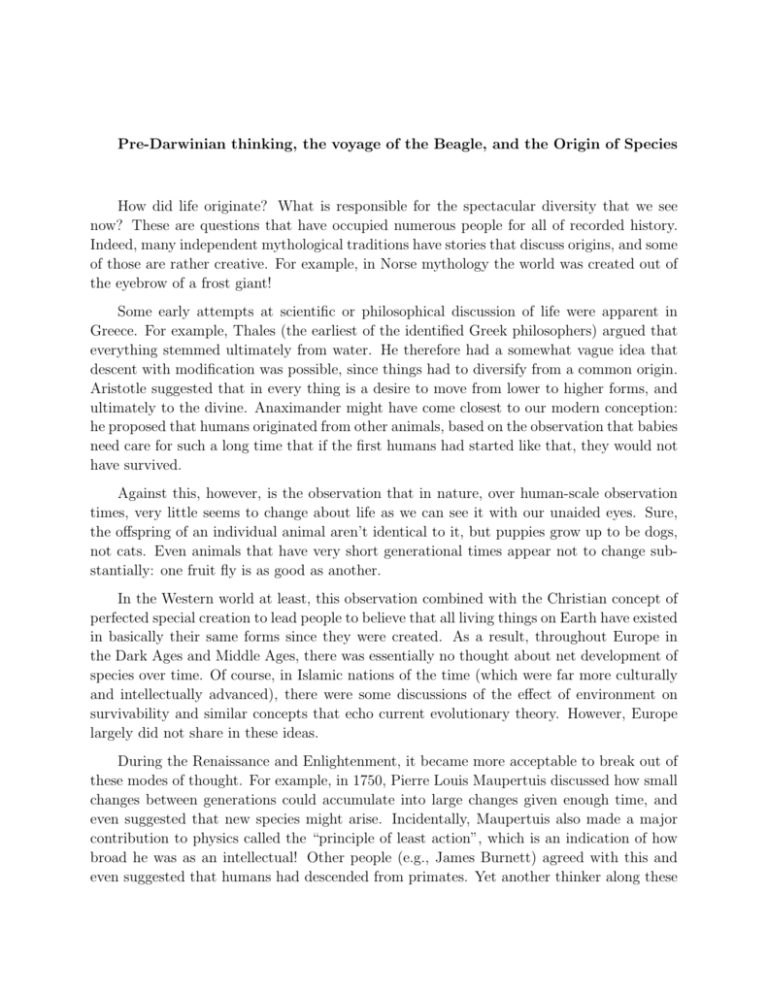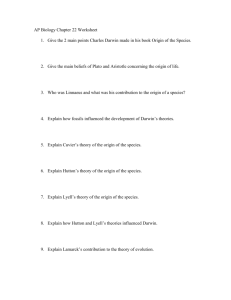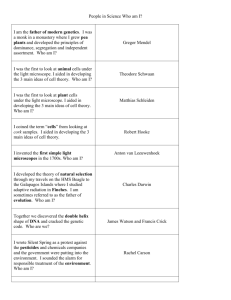Pre-Darwinian thinking, the voyage of the Beagle, and the Origin of
advertisement

Pre-Darwinian thinking, the voyage of the Beagle, and the Origin of Species How did life originate? What is responsible for the spectacular diversity that we see now? These are questions that have occupied numerous people for all of recorded history. Indeed, many independent mythological traditions have stories that discuss origins, and some of those are rather creative. For example, in Norse mythology the world was created out of the eyebrow of a frost giant! Some early attempts at scientific or philosophical discussion of life were apparent in Greece. For example, Thales (the earliest of the identified Greek philosophers) argued that everything stemmed ultimately from water. He therefore had a somewhat vague idea that descent with modification was possible, since things had to diversify from a common origin. Aristotle suggested that in every thing is a desire to move from lower to higher forms, and ultimately to the divine. Anaximander might have come closest to our modern conception: he proposed that humans originated from other animals, based on the observation that babies need care for such a long time that if the first humans had started like that, they would not have survived. Against this, however, is the observation that in nature, over human-scale observation times, very little seems to change about life as we can see it with our unaided eyes. Sure, the offspring of an individual animal aren’t identical to it, but puppies grow up to be dogs, not cats. Even animals that have very short generational times appear not to change substantially: one fruit fly is as good as another. In the Western world at least, this observation combined with the Christian concept of perfected special creation to lead people to believe that all living things on Earth have existed in basically their same forms since they were created. As a result, throughout Europe in the Dark Ages and Middle Ages, there was essentially no thought about net development of species over time. Of course, in Islamic nations of the time (which were far more culturally and intellectually advanced), there were some discussions of the effect of environment on survivability and similar concepts that echo current evolutionary theory. However, Europe largely did not share in these ideas. During the Renaissance and Enlightenment, it became more acceptable to break out of these modes of thought. For example, in 1750, Pierre Louis Maupertuis discussed how small changes between generations could accumulate into large changes given enough time, and even suggested that new species might arise. Incidentally, Maupertuis also made a major contribution to physics called the “principle of least action”, which is an indication of how broad he was as an intellectual! Other people (e.g., James Burnett) agreed with this and even suggested that humans had descended from primates. Yet another thinker along these lines was Erasmus Darwin, Charles’ grandfather. Another major development occurred in the early 1800s via geology and paleontology. Georges Cuvier showed that mammoths were distinct from elephants and had gone extinct, which proved that extinction was indeed possible and thus opened the door for different organisms in the past than currently. Even more importantly, Cuvier, Charles Lyell, and others used their research and writings to demonstrate that the Earth has to be tremendously old. Lyell in particular was influential because he advocated the principle of uniformitarianism, i.e., that the Earth has changed its properties gradually rather than by the catastrophic events that were previously assumed to have produced mountains, facilitated extinctions, and so on. Ironically enough, both Cuvier and Lyell personally believed in the immutability of species and Lyell in particular was opposed to evolution, but the case he set out for an old Earth was ultimately one of the motivations for Darwin. If change does happen, though, what could be the mechanism? Jean-Baptiste Lamarck proposed in 1809 that transmutation of species could be produced by individuals adapting to their environments during their lifetimes. For example, he believed that giraffes acquired long necks because they would stretch their necks to reach high leaves. Having done this, their progeny would start out with longer necks. This is not what we now think happened. In fact, when the Soviet geneticist Trofim Lysenko tried to apply these principles to farming (since he argued they were consistent with Marxist principles), he brought in multiple substandard harvests and set Soviet genetics back a generation. Other people during the next few decades proposed different ideas, some very close to what Darwin would suggest, but most did not recognize the true importance of their concepts and none provided observational evidence. The stage was set for the entrance of Charles Darwin. The voyage of the Beagle Charles Darwin was born on February 12, 1809 in England, exactly the same day that Abraham Lincoln was born in Kentucky. His father was a medical doctor, and in his early years it appeared that Charles would follow in his footsteps. However, his time as an apprentice doctor in 1825 led to revulsion at the brutality of surgery (remember, they had no anasthesia at that time!). He then became interested in natural history and geology, but his father was disappointed with what he saw as a lack of direction and therefore enrolled Charles in a bachelor of arts program at Christ’s College, Cambridge, to study for the clergy. After he finished his studies, he spent some time surveying rock strata in Wales. Then, in the fall of 1831, at the age of 22, he received a letter that was to change his life. The letter was from Reverend John Henslow, a Cambridge professor of botany who had been very influential during Darwin’s student days. It said that 26 year old Captain Robert FitzRoy, who was to lead the planned two-year voyage of the HMS Beagle to South America and elsewhere, had requested a gentleman’s companion during the voyage so that FitzRoy wouldn’t go crazy (as did the previous captain, who committed suicide!). After some twists and turns (Darwin’s father thought it was a waste of time; FitzRoy himself almost rejected Darwin because Darwin’s nose supposedly indicated a lack of resolve!), Darwin, FitzRoy, and crew set off on December 27, 1831. The voyage itself lasted five years instead of two. At the beginning, FitzRoy gave Darwin a present of Charles Lyell’s “Principles of Geology”, which made the case for uniformitarianism and influenced Darwin greatly. Throughout the voyage, Darwin became gradually more convinced of the evidence for a large age of the Earth. More importantly for our purposes, he saw numerous small variations in different species, which put in his mind that these might have diverged from a common ancestor. Ironically enough, what was to become the most famous example of this (the many different species of finches on the Galapagos Islands) was a case where (1) Darwin misidentified a number of the birds, and (2) he didn’t keep track of which specimen came from where. Luckily other people on the expedition kept better notes, and since Darwin sent all his samples back to England along the way specialists were able to examine them. The voyage was long enough that Darwin had multiple important changes to his view of life and the history of Earth: • Darwin began fairly convinced by William Paley’s argument for special creation of each and every species. The classic Paley argument is that if one encountered a watch, one would know immediately that it had been designed by an intelligent entity because of its intricacy. Life is even more intricate, so the conclusion seemed obvious. • However, during Darwin’s travels he saw many closely-related species. For example, Darwin’s finches are 13 different species that have different sizes, beak lengths, etc. but are otherwise very close indeed. He began to wonder: why would individual special creation be requred for each of these, when he knew from first-hand experience that artificial breeding could produce radical changes in a relatively short time? Consider, for example, how diverse dogs are. Chihuahuas are rather different from Great Danes, but they come from a common ancestor. Could nature have done the same thing over longer timescales? Darwin also saw many extinct forms that were close to living species. • Another critical evolution of his views was that he saw many geological formations and occurances (including an earthquake) that were in accord with Lyell’s uniformitarianism. This was important because it implied that the Earth has been around for a long time, thus allowing life to develop much more than it would otherwise. When Darwin returned to England, he found himself a scientific celebrity because Henslow had allowed key naturalists access to the specimens Darwin had sent back as well as his letters on geology. One of those naturalists was Richard Owen, who identified many of the fossils Darwin had found but was later to become one of his bitterest enemies. For the moment, though, Darwin was the toast of scientific England. The Origin of Species We now skip forward about twenty years. The subject of transmutation of species was one that met with significant emotion, because to some it suggested that somehow the initial creation was incomplete. Other people proposed ideas to try to bridge the gap, e.g., Lyell suggested a “law of succession” in which mammals would be replaced by similar mammals (still specially created) on each continent. However, those who proposed actual transmutation (e.g., the anonymous author of the November 1844 publication “Vestiges of the Natural History of Creation”) were met with a storm of protest. Darwin had been sensing such problems for a while, and indeed in 1837 had begun keeping a secret notebook in which he put his own speculations. His concern kept him from publication, because he wanted to amass more and more evidence and answer all the objections he could conceive. However, on June 18, 1858, he received a paper from Alfred Russel Wallace that described natural selection in a form very similar to Darwin’s. Darwin had had correspondence with Wallace before and knew that Wallace was thinking about the introduction of species, but was stunned by how closely Wallace anticipated many of Darwin’s own idea. Darwin then suggested to Wallace that their papers be presented jointly at a conference, and they were, but neither was able to attend in person. The presentations sank without a ripple, with the only review being that of a certain Professor Haughton of Dublin: “all that was new in them was false, and what was true was old.” Darwin then worked hard at a book on his findings, and on November 22, 1859 he published “The Origin of Species” (actually an abbreviation for its long title). It is a long book, with many detailed arguments, but the thesis is set out in the introduction: “As many more individuals of each species are born than can possibly survive; and as, consequently, there is a frequently recurring struggle for existence, it follows that any being, if it vary however slightly in any manner profitable to itself, under the complex and sometimes varying conditions of life, will have a better chance of surviving, and thus be naturally selected. From the strong principle of inheritance, any selected variety will tend to propagate its new and modified form.” His conclusion is poetic enough to include as well: “There is grandeur in this view of life, with its several powers, having been originally breathed into a few forms or into one; and that, whilst this planet has gone cycling on according to the fixed law of gravity, from so simple a beginning endless forms most beautiful and most wonderful have been, and are being, evolved.” Reaction to the Origin Reaction by the public and the scientific community was swift. All 1,170 copies of the first printing were purchased on the very first day, and a new run of 3,000 copies was quickly bought out after their release on January 7, 1860. This was rather a surprising reaction, but indicated the thirst for understanding of life’s development. Although the Origin did not explicitly discuss human evolution, the implications were clear and immediately divided the scientific establishment. Owen, Lyell, Darwin’s old mentor Haslow, and many others took theological exception to the “men from monkeys” implication, as did the Church of England. However, liberal theologians and many of the younger scientists saw this as a beautiful way for one or a few initial forms to diversify. Indeed, there is some (disputed) evidence that Darwin himself looked at this mechanism as the way God did things, as opposed to a substitute for a creator. Conflicts have never ceased since, but the most famous of the confrontations of the early days was that between Samuel Wilberforce (the Bishop of Oxford) and Thomas Huxley, a biologist who was to become known as “Darwin’s bulldog”. At a debate at Oxford in 1860, “Soapy Sam” (known as such for his rhetorical slipperyness) finished a sarcastic condemnation of Darwin by asking Huxley if he was descended from monkeys on his grandfather’s side or his grandmother’s. According to legend, Huxley muttered: “The Lord has delivered him into my hands” and replied that he “would rather be descended from an ape than from a cultivated man who used his gifts of culture and eloquence in the service of prejudice and falsehood”. This probably didn’t really happen, but it stands as an important establishment of the importance of basing scientific arguments on evidence, right up there with Galileo whispering “and yet it still moves” after being forced by the Catholic Church to renounce Copernicanism. Darwin went on to produce six editions of the book. He also wrote “The Descent of Man” to discuss human evolution, as well as more specialized books on orchids and worms. He was buried in Westminster Abbey near Isaac Newton, properly honored as one of the greatest scientists in history. Subsequent development of evolution Given that biology is by far the largest of the sciences in terms of number of participants, and that evolutionary biology is its most important synthesizing component, we can hardly give a fair summary beyond a few highlights. One critical issue left unresolved by Darwin was the actual mechanism of heredity. This was demonstrated first by the Austrian monk Gregor Mendel, who did a famous series of experiments on pea plants that established patterns of heritability. He is therefore considered by many to be the father of genetics. His work, although published in 1866, languished in obscurity until 1900. At that point, two people (Hugo de Vries and Carl Correns) discovered the patterns of heredity independently of each other and of Mendel. Being good scientists, both searched the literature, both found Mendel’s 1866 publication, and both credited Mendel with the discovery. All in all, that’s a pretty unlikely series of events! Nonetheless, Mendel now had credit for his discoveries. For a few decades, though, Mendel’s work was considered to conflict with Darwin’s idea of gradual small changes because genetic changes can be abrupt (e.g., eye color can change radically from one generation to the next). All this was, however, resolved in what is now called the “modern evolutionary synthesis”. Basically, genes regulate the individual, and genes are what change from generation to generation. Now the pace of molecular and evolutionary biology is truly fantastic. The full genome (i.e., sequence of molecular rungs in the ladder of DNA) has been sequenced for humans as well as for a rapidly growing list of other animals, plants, bacteria, and archea. This has in fact become so common that DNA analysis is regularly used to evaluate guilt in crimes as well as parenthood. In summary, although the current view of evolution is vastly more sophisticated than Darwin could ever have imagined, the basic principles have been tested over and over again for nearly 150 years and the theory has passed every single time with flying colors. We will discuss some of the evidence for evolution in the third and fourth lectures in this series, but first we will take a diversion to discuss some of the misunderstandings that are unfortunately common about evolutionary ideas.








